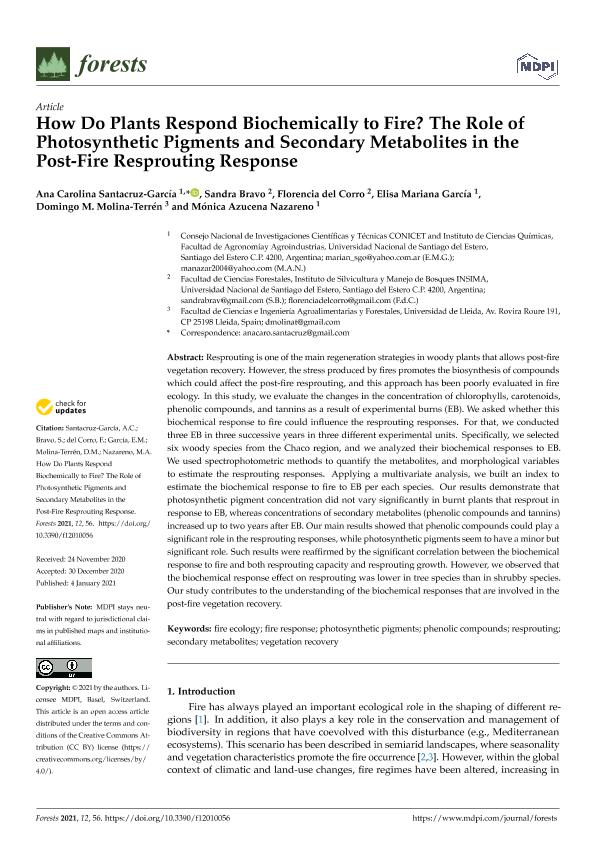Artículo
How do plants respond biochemically to fire? The role of photosynthetic pigments and secondary metabolites in the post-fire resprouting response
Santacruz García, Ana Carolina ; Bravo, Sandra; del Corro, Florencia Inés
; Bravo, Sandra; del Corro, Florencia Inés ; García, Elisa Mariana
; García, Elisa Mariana ; Molina Terrén, Domingo M.; Nazareno, Mónica Azucena
; Molina Terrén, Domingo M.; Nazareno, Mónica Azucena
 ; Bravo, Sandra; del Corro, Florencia Inés
; Bravo, Sandra; del Corro, Florencia Inés ; García, Elisa Mariana
; García, Elisa Mariana ; Molina Terrén, Domingo M.; Nazareno, Mónica Azucena
; Molina Terrén, Domingo M.; Nazareno, Mónica Azucena
Fecha de publicación:
01/2021
Editorial:
MDPI AG
Revista:
Forests
ISSN:
1999-4907
Idioma:
Inglés
Tipo de recurso:
Artículo publicado
Clasificación temática:
Resumen
Resprouting is one of the main regeneration strategies in woody plants that allows post-fire vegetation recovery. However, the stress produced by fires promotes the biosynthesis of compounds which could affect the post-fire resprouting, and this approach has been poorly evaluated in fire ecology. In this study, we evaluate the changes in the concentration of chlorophylls, carotenoids, phenolic compounds, and tannins as a result of experimental burns (EB). We asked whether this biochemical response to fire could influence the resprouting responses. For that, we conducted three EB in three successive years in three different experimental units. Specifically, we selected six woody species from the Chaco region, and we analyzed their biochemical responses to EB. We used spectrophotometric methods to quantify the metabolites, and morphological variables to estimate the resprouting responses. Applying a multivariate analysis, we built an index to estimate the biochemical response to fire to EB per each species. Our results demonstrate that photosynthetic pigment concentration did not vary significantly in burnt plants that resprout in response to EB, whereas concentrations of secondary metabolites (phenolic compounds and tannins) increased up to two years after EB. Our main results showed that phenolic compounds could play a significant role in the resprouting responses, while photosynthetic pigments seem to have a minor but significant role. Such results were reaffirmed by the significant correlation between the biochemical response to fire and both resprouting capacity and resprouting growth. However, we observed that the biochemical response effect on resprouting was lower in tree species than in shrubby species. Our study contributes to the understanding of the biochemical responses that are involved in the post-fire vegetation recovery.
Archivos asociados
Licencia
Identificadores
Colecciones
Articulos(CCT - NOA SUR)
Articulos de CTRO.CIENTIFICO TECNOL.CONICET - NOA SUR
Articulos de CTRO.CIENTIFICO TECNOL.CONICET - NOA SUR
Citación
Santacruz García, Ana Carolina; Bravo, Sandra; del Corro, Florencia Inés; García, Elisa Mariana; Molina Terrén, Domingo M.; et al.; How do plants respond biochemically to fire? The role of photosynthetic pigments and secondary metabolites in the post-fire resprouting response; MDPI AG; Forests; 12; 1; 1-2021; 1-20
Compartir
Altmétricas



